 |
 |
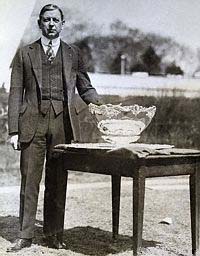
Dwight Davis and the famous cup in 1924 |
The very first years of the Davis Cup: 1900-1914
|
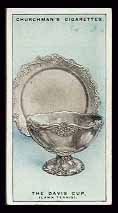
The Davis cup tobacco card 1928. |
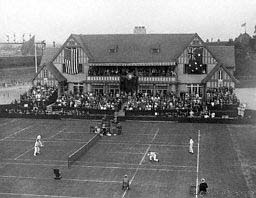
Davis cup at Forest Hills. |
It
was in 1900 that a 25 year old American student had the idea of pitching
a national team against the British and, in particular, the All England
Lawn Tennis And Croquet Club. He bought a very large, very ugly but very
prestigious silver cup for the princely sum of $1,000 and threw down the
gauntlet for a team competition comprising five games of four men's singles
and one doubles.
The generous donator was a certain Mr Dwight Davis who had won the US championships in 1899 having also been an unsuccessful finalist the year before. He was, much later, to become a famous statesman and ultimately Minister of War for his country, but it was the Davis Cup that was to immortalise his name. |
| Whilst more
detailed rules were set down and agreed between the British and USA Lawn
Tennis Associations, the fundamental principles for the competition were
very straight forward: The winning team kept the trophy until such time
that another national squad declared a wish to challenge for the title.
If more than one team wished to mount a challenge they had to undertake
between them a knock out round/rounds before meeting the title holders
in a final "Challenge Round".The famous "America's Cup" for which the high
ranking yacht clubs of the world make challenge remains subject to the
very same principles to this day. The Davis Cup however, to a certain extent
a victim of it's own success, abandoned these principles in 1973 in order
to open the competition up to a much wider forum.
The principal events of the Davis Cup in it's early years may be summarised as follows:
|
|
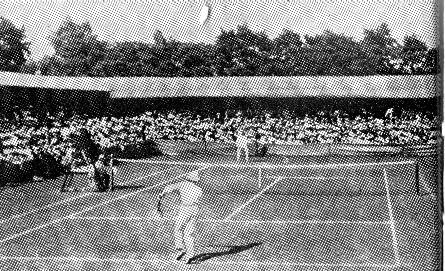
Wimbledon 1907 : Davis cup match between Australia et U.K. : Brookes is serving |
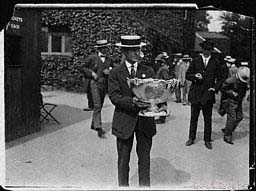
The Davis cup: back in the USA, 1913 |
|
| 1914 : The bad year. Only the Australians and the Germans decide to take the battle to America. The Australians reconvene the successful partnership of Brookes and Wilding that had taken the cup so convincingly in 1907. The first match however is set in an overbearing atmosphere that war is about to be declared in Europe at any second. The Germans Froitzheim and Kreuser announce from the outset their intention to stop the match immediately should this happen. War is in fact finally declared only a matter of hours after the Australians win the knock out round. They go on to beat the Americans McLoughlin and Williams 3/2 in the Challenge Round. McLoughlin has the satisfaction of winning his two singles matches but this is not enough. For the Australian Wilding, this will sadly be his final victory. Having signed up voluntarily to the British Army, he is killed in action at the front in 1915. | 
The german team in 1914 : Froitzheim and Kreuzer |
| In less than fourteen years,
the Davis Cup had become a truly great team competition. It's impact in
nurturing the birth of the Grand Slam is quite clear. The knock out and
Challenge Rounds were normally contested between the national champions
of the competing countries. This forum then allowed these champions to
go on to compete in the associated local championships. Hence we find the
Englishman Laurie Doherty winning the US in 1903, the Australian Norman
Brookes at Wimbledon in 1907, the Englishman Parke in Australia in 1912.
Only one thing was really missing now. This was of course the French Championship
since it remained closed to foreign players. As we already know, this was
not to last much longer.
Let's now have a closer
look at Laurie
Doherty and
Anthony Wilding who were
the two most outstanding players before the outbreak of war in 1914. Each
of these players, in his own way, won a grand slam:
|
Previous story : The
early years of the Men's French Championship: 1891-1914
Next story : The
Doherty era
 E-mail
E-mail
Dernière mise à jour : 12
Mai 2000.
Copyright BLANCHE NET communications.
Mars 2000.